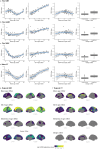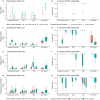This is a preprint.
Study design features increase replicability in cross-sectional and longitudinal brain-wide association studies
- PMID: 37398345
- PMCID: PMC10312450
- DOI: 10.1101/2023.05.29.542742
Study design features increase replicability in cross-sectional and longitudinal brain-wide association studies
Update in
-
Study design features increase replicability in brain-wide association studies.Nature. 2024 Dec;636(8043):719-727. doi: 10.1038/s41586-024-08260-9. Epub 2024 Nov 27. Nature. 2024. PMID: 39604734 Free PMC article.
Abstract
Brain-wide association studies (BWAS) are a fundamental tool in discovering brain-behavior associations. Several recent studies showed that thousands of study participants are required for good replicability of BWAS because the standardized effect sizes (ESs) are much smaller than the reported standardized ESs in smaller studies. Here, we perform analyses and meta-analyses of a robust effect size index using 63 longitudinal and cross-sectional magnetic resonance imaging studies from the Lifespan Brain Chart Consortium (77,695 total scans) to demonstrate that optimizing study design is critical for increasing standardized ESs and replicability in BWAS. A meta-analysis of brain volume associations with age indicates that BWAS with larger variability in covariate have larger reported standardized ES. In addition, the longitudinal studies we examined reported systematically larger standardized ES than cross-sectional studies. Analyzing age effects on global and regional brain measures from the United Kingdom Biobank and the Alzheimer's Disease Neuroimaging Initiative, we show that modifying longitudinal study design through sampling schemes improves the standardized ESs and replicability. Sampling schemes that improve standardized ESs and replicability include increasing between-subject age variability in the sample and adding a single additional longitudinal measurement per subject. To ensure that our results are generalizable, we further evaluate these longitudinal sampling schemes on cognitive, psychopathology, and demographic associations with structural and functional brain outcome measures in the Adolescent Brain and Cognitive Development dataset. We demonstrate that commonly used longitudinal models can, counterintuitively, reduce standardized ESs and replicability. The benefit of conducting longitudinal studies depends on the strengths of the between- versus within-subject associations of the brain and non-brain measures. Explicitly modeling between- versus within-subject effects avoids averaging the effects and allows optimizing the standardized ESs for each separately. Together, these results provide guidance for study designs that improve the replicability of BWAS.
Figures





References
-
- Nosek B. A. et al. Replicability, Robustness, and Reproducibility in Psychological Science. Annu. Rev. Psychol. 73, 719–748 (2022). - PubMed
Publication types
Grants and funding
LinkOut - more resources
Full Text Sources
